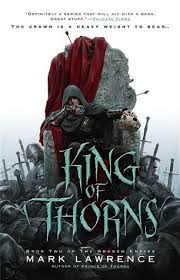
2‑King of Thorns
Chapter 11: Four years earlier
by Mark, Lawrence,The chapter “10: Four years earlier” serves as a flashback, providing crucial context for the events unfolding in *King of Thorns*, the second book of *The Broken Empire* series. It revisits a pivotal period in the protagonist’s past, shedding light on formative experiences that shaped his current motivations and actions. The narrative likely explores key moments of conflict, betrayal, or personal growth, anchoring the present storyline in a deeper historical framework. This temporal shift underscores the nonlinear storytelling style characteristic of the series.
The excerpt suggests a focus on the protagonist’s earlier struggles, possibly detailing his rise to power or the origins of his ruthless reputation. Themes of ambition, survival, and moral ambiguity are likely central, as the chapter delves into the harsh realities of the Broken Empire’s world. The flashback may reveal alliances forged or broken, as well as the consequences of past decisions that continue to reverberate in the present. The sparse provided content implies a deliberate, impactful narrative style.
While the chapter’s specific events are not detailed in the given excerpt, its placement as “10” indicates it is a significant mid-point revelation. The title “Four years earlier” hints at a direct connection to the main timeline, possibly explaining the protagonist’s current circumstances or mindset. The flashback device is used to enrich character development and plot complexity, offering readers a clearer understanding of the protagonist’s journey and the empire’s fractured state.
The brevity of the provided excerpt suggests the chapter relies on vivid, concise storytelling to convey its backstory. The flashback likely serves to juxtapose past and present, highlighting contrasts or parallels in the protagonist’s evolution. This technique deepens reader engagement by unraveling the protagonist’s history in measured reveals, maintaining suspense while providing essential context for the overarching narrative of *The Broken Empire* series.
FAQs
1. What is the significance of the chapter title “10: Four years earlier” in the context of King of Thorns?
Answer:
The chapter title “10: Four years earlier” indicates a flashback or temporal shift in the narrative, which is a common storytelling technique in King of Thorns. This structure allows the author to provide background context for the protagonist’s current situation, revealing formative events that shaped his character and decisions. By jumping back four years, the chapter likely explores pivotal moments that explain the protagonist’s motivations, alliances, or conflicts in the present timeline of the Broken Empire series.2. How does the chapter “10: Four years earlier” contribute to the overarching themes of power and ambition in King of Thorns?
Answer:
This chapter likely delves into the protagonist’s earlier struggles or triumphs, illustrating how his pursuit of power began or intensified. By showing events from four years prior, it may reveal key turning points—such as battles, betrayals, or alliances—that fueled his ambition. The flashback structure emphasizes how past experiences harden the protagonist, aligning with the series’ themes of ruthless ambition and the costs of wielding power in a fractured world.3. What narrative purpose does a flashback chapter like “10: Four years earlier” serve in a dark fantasy novel like King of Thorns?
Answer:
Flashbacks in dark fantasy often serve to deepen character complexity and justify morally ambiguous actions. In this chapter, the four-year jump likely unveils traumatic or transformative events that explain the protagonist’s current ruthlessness or strategic brilliance. It also creates suspense by contrasting past vulnerabilities with present power, inviting readers to piece together how the character evolved. This technique enriches world-building and reinforces the grim tone of the Broken Empire universe.4. How might the events of “10: Four years earlier” foreshadow future conflicts in King of Thorns?
Answer:
The chapter’s events likely plant seeds for later plot developments, such as unresolved rivalries, hidden enemies, or unfulfilled vows. For example, a betrayal or alliance formed four years earlier could resurface in the present timeline with dramatic consequences. By revisiting the past, the author hints at future confrontations or revelations, ensuring that the flashback isn’t merely expository but actively drives the narrative forward.5. In what ways does the non-linear storytelling in “10: Four years earlier” challenge readers’ perceptions of the protagonist?
Answer:
Non-linear storytelling forces readers to reassess the protagonist’s actions by revealing formative experiences. If the chapter shows him as more vulnerable or idealistic in the past, it creates a contrast with his present ruthlessness, adding layers to his morality. Alternatively, it might expose hidden depths of manipulation or trauma that reframe his current decisions. This technique invites readers to engage critically with his character rather than accepting him at face value.
Quotes
1. “The memories of men are too frail a thread to hang history from.”
This quote reflects the book’s recurring theme of the unreliability of memory and perception, particularly in how history is recorded and interpreted. It appears early in the chapter, setting the stage for the narrative’s exploration of subjective truth.
2. “Some truths are too sharp to hold without bleeding.”
A powerful metaphor about painful realities that foreshadows difficult revelations in the chapter. This represents the book’s exploration of how characters grapple with harsh truths about themselves and their world.
3. “Four years can change a boy into a man. Four years can change a man into a king. Or a monster.”
This pivotal quote captures the chapter’s central theme of transformation and the passage of time. It highlights the protagonist’s evolution and the ambiguous nature of power and leadership in the narrative.
4. “The road to hell is paved with good intentions, but the road to power is paved with bodies.”
A stark commentary on the brutal realities of political ascent in the story’s world. This quote exemplifies the book’s cynical perspective on power dynamics and moral compromise.
5. “When you wear a crown, everyone remembers your age except you.”
This insightful observation about leadership and perception comes late in the chapter, summarizing the isolation and weight of responsibility that comes with power in the narrative.
